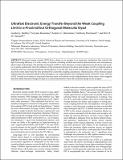Files in this item
Ultrafast electronic energy transfer beyond the weak coupling limit in a proximal but orthogonal molecular dyad
Item metadata
| dc.contributor.author | Hedley, Gordon J. | |
| dc.contributor.author | Ruseckas, Arvydas | |
| dc.contributor.author | Benniston, Andrew C. | |
| dc.contributor.author | Harriman, Anthony | |
| dc.contributor.author | Samuel, Ifor D. W. | |
| dc.date.accessioned | 2016-11-29T00:33:43Z | |
| dc.date.available | 2016-11-29T00:33:43Z | |
| dc.date.issued | 2015-12-24 | |
| dc.identifier | 242658648 | |
| dc.identifier | 4797c75f-7a7a-410a-bbb6-6714725ad64c | |
| dc.identifier | 000367561100009 | |
| dc.identifier | 84952891068 | |
| dc.identifier | 000367561100009 | |
| dc.identifier.citation | Hedley , G J , Ruseckas , A , Benniston , A C , Harriman , A & Samuel , I D W 2015 , ' Ultrafast electronic energy transfer beyond the weak coupling limit in a proximal but orthogonal molecular dyad ' , Journal of Physical Chemistry A , vol. 119 , no. 51 , pp. 12665-12671 . https://doi.org/10.1021/acs.jpca.5b08640 | en |
| dc.identifier.issn | 1089-5639 | |
| dc.identifier.other | ORCID: /0000-0001-9114-3522/work/32543060 | |
| dc.identifier.uri | https://hdl.handle.net/10023/9893 | |
| dc.description.abstract | Electronic energy transfer (EET) from a donor to an acceptor is an important mechanism that controls the light harvesting efficiency in a wide variety of systems, including artificial and natural photosynthesis and contemporary photovoltaic technologies. The detailed mechanism of BET at short distances or large angles between the donor and acceptor is poorly understood. Here the influence of the orientation between the donor and acceptor on EET is explored using a molecule with two nearly perpendicular chromophores. Very fast EET with a time constant of 120 fs is observed, which is at least 40 times faster than the time predicted by Coulombic coupling calculations. Depolarization of the emission signal indicates that the transition dipole rotates through ca. 64 degrees, indicating the near orthogonal nature of the EET event. The rate of EET is found to be similar to structural relaxation rates in the photoexcited oligothiophene donor alone, which suggests that this initial relaxation brings the dyad to a conical intersection where the excitation jumps to the acceptor. | |
| dc.format.extent | 7 | |
| dc.format.extent | 861425 | |
| dc.language.iso | eng | |
| dc.relation.ispartof | Journal of Physical Chemistry A | en |
| dc.subject | Excitation transfer | en |
| dc.subject | Quantum coherence | en |
| dc.subject | Forster theory | en |
| dc.subject | Systems | en |
| dc.subject | Photoluminescence | en |
| dc.subject | QD Chemistry | en |
| dc.subject | TP Chemical technology | en |
| dc.subject | NDAS | en |
| dc.subject | SDG 7 - Affordable and Clean Energy | en |
| dc.subject.lcc | QD | en |
| dc.subject.lcc | TP | en |
| dc.title | Ultrafast electronic energy transfer beyond the weak coupling limit in a proximal but orthogonal molecular dyad | en |
| dc.type | Journal article | en |
| dc.contributor.sponsor | EPSRC | en |
| dc.contributor.sponsor | European Research Council | en |
| dc.contributor.institution | University of St Andrews. School of Physics and Astronomy | en |
| dc.contributor.institution | University of St Andrews. Condensed Matter Physics | en |
| dc.identifier.doi | https://doi.org/10.1021/acs.jpca.5b08640 | |
| dc.description.status | Peer reviewed | en |
| dc.date.embargoedUntil | 2016-11-28 | |
| dc.identifier.grantnumber | N/A | en |
| dc.identifier.grantnumber | en |
This item appears in the following Collection(s)
Items in the St Andrews Research Repository are protected by copyright, with all rights reserved, unless otherwise indicated.

